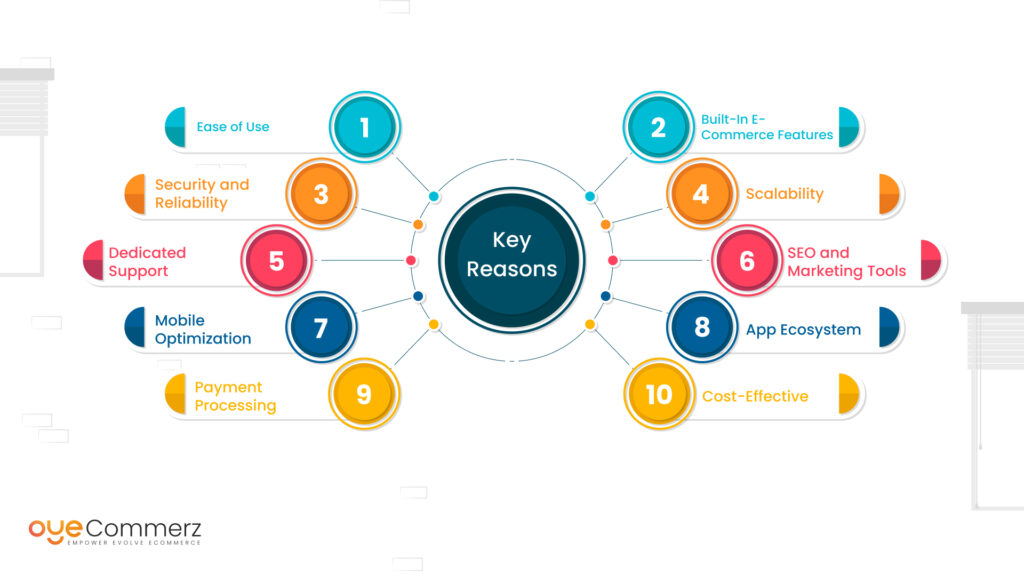Shifting from WP to Shopify is an exciting step in streamlining your online store processes. As companies grow, selecting a platform that supports growth potential, UX, and customization becomes crucial. Shopify has emerged as a favorite for online merchants, providing superior adaptability, data protection, and ease of use. In this guide, we will delve into the transformative impact of this migration, highlight the advantages, and provide practical tips to ensure a smooth transition.
1. Top Reasons to Transition from WP to Shopify
WordPress, paired with WooCommerce, continues to support countless e-commerce platforms. Nevertheless, as companies expand, issues like reliance on plugins, security vulnerabilities, and technical complexities often obstruct growth. Shopify, designed explicitly for e-commerce, eliminates these concerns with an all-in-one, intuitive platform. Statistics supports this shift—Shopify hosts over 4.4 million websites globally, with a reported 10% boost to sales conversion rates for numerous merchants after migration.
2. Key Benefits of Shopify for E-commerce Success
Shopify’s robust ecosystem caters for scaling brands. Its standout features include:
- Effortless Design Flexibility: Shopify provides over 80 expertly crafted themes.
- Built-in Features: Features like Shopify Payments and integrated SEO save time and effort.
- International Expansion: Currency versatility and regional customization enable businesses to reach global markets.
Additionally, Shopify boasts an availability percentage of 99.98%, guaranteeing your website is always operational.
3. Getting Ready for Your WordPress-to-Shopify Transition
Before migrating, assess your existing setup. Review product data, customer details, and search engine rankings. Resources such as Shopify’s Migration Kit or external tools can simplify this process. Create a detailed strategy, making sure all assets—item details, media files, and blog content—are optimized for transfer.
4. The Importance of Accurate Data Migration
Data migration is a cornerstone of a successful platform switch. When migrating from WordPress to Shopify, prioritize:
- Product Information: SKU, item summaries, and groupings.
- Customer Data: Emails, order history, and preferences.
- SEO Optimization: Preserve meta tags, URLs, and forwarding paths to avoid SEO losses.
Leverage apps like LitExtension to facilitate seamless migration while reducing mistakes.
5. Tailoring Your Shopify Store to Fit Your Brand
Post-migration, customizing your Shopify store ensures it aligns with your brand. Utilize Shopify’s intuitive page builder to create layouts with ease. Shopify's themes are mobile-responsive, providing a smooth user experience across platforms—a key point, since 74% of e-commerce traffic comes from mobile visitors.
6. Maintaining SEO During Migration
SEO is vital for maintaining your visibility during migration. Shopify excels in SEO with organized link formatting, built-in optimization tools, and smooth content management. Make sure you:
- Implement 301 redirects for existing links.
- Enhance updated content with targeted phrases.
- Leverage plugins like Plug in SEO to monitor performance post-migration.
7. Essential Tests After Migrating to Shopify
After finishing the transfer, conduct thorough testing.
Check:- Page load times (Shopify boasts faster speeds compared to WP). Shopify store migration checklist
- Functionality of payment gateways and transaction flow.
- Mobile responsiveness.
Testing ensures your store provides a smooth shopping journey from the start.
8. Real-Life Success Story
One such E-commerce re-platforming migration success story is Gymshark, a fitness apparel brand that moved to Shopify. After the switch, the company saw a 60% boost in mobile sales and significantly lowered site downtime. This highlights the potential of Shopify in driving online business success.
9. Overcoming Common Migration Issues
Migration comes with challenges, such as data integrity and reconfiguring custom functionalities. However, Shopify’s extensive assistance and external professionals simplify the process. Collaborating with experienced Shopify developers ensures a trouble-free transition.
10. Making the Switch: The First Step Toward Success
Migrating from WordPress to Shopify marks a strategic approach to online retail. By focusing on growth, simplifying management, and enhancing the customer experience, Shopify enables companies to thrive in competitive markets.
Final Thoughts
Switching from WordPress to Shopify offers a smart solution that can significantly boost your online business performance. With a well-structured strategy, the appropriate resources, and expert support, you can achieve new growth opportunities.
Ready to make the leap? Reach out today to learn how our Shopify migration services can revolutionize your online store. Get in touch today, or consider: Is it time to seize Shopify’s advantages for your store?

Comments on “Effortless Transition from WordPress to Shopify: Your Definitive Guide to E-commerce Success”